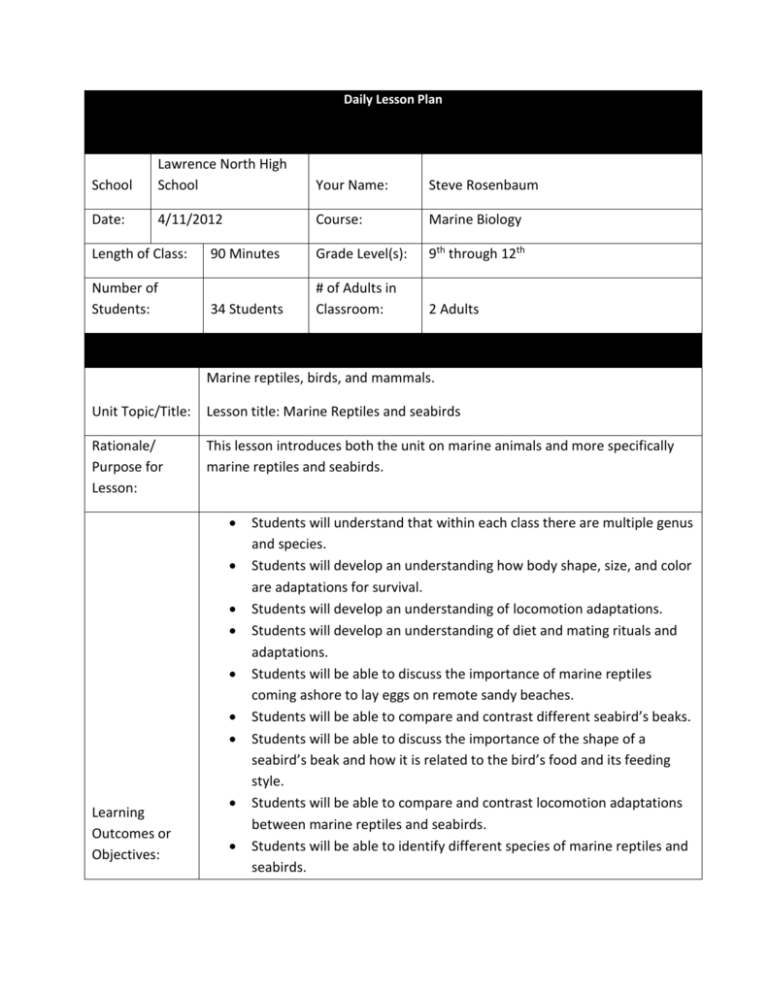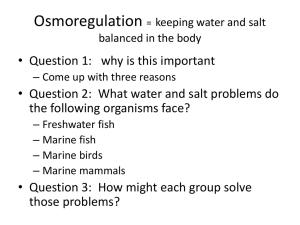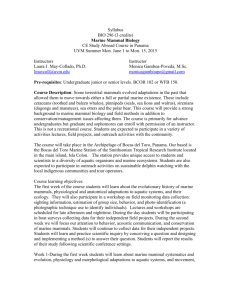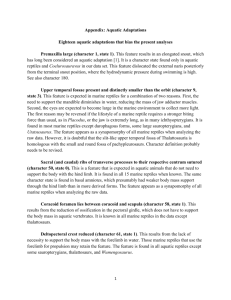High School
advertisement

Daily Lesson Plan School Lawrence North High School Your Name: Steve Rosenbaum Date: 4/11/2012 Course: Marine Biology 90 Minutes Grade Level(s): 9th through 12th 34 Students # of Adults in Classroom: 2 Adults Length of Class: Number of Students: Marine reptiles, birds, and mammals. Unit Topic/Title: Lesson title: Marine Reptiles and seabirds Rationale/ Purpose for Lesson: This lesson introduces both the unit on marine animals and more specifically marine reptiles and seabirds. Learning Outcomes or Objectives: Students will understand that within each class there are multiple genus and species. Students will develop an understanding how body shape, size, and color are adaptations for survival. Students will develop an understanding of locomotion adaptations. Students will develop an understanding of diet and mating rituals and adaptations. Students will be able to discuss the importance of marine reptiles coming ashore to lay eggs on remote sandy beaches. Students will be able to compare and contrast different seabird’s beaks. Students will be able to discuss the importance of the shape of a seabird’s beak and how it is related to the bird’s food and its feeding style. Students will be able to compare and contrast locomotion adaptations between marine reptiles and seabirds. Students will be able to identify different species of marine reptiles and seabirds. AS. 1.1 Explain the classification of organisms based on hierarchical taxonomy including kingdom, division, class, order, family, genus, and species. AS. 1.4 Identify the major features of chordates, identify the highlights of vertebrate evolution (development of jaws, cartilage, to bone, and water to land), and identify the distinguishing characters of fish, birds, and mammals. AS. 1.4 Identify the major features of chordates, identify the highlights of vertebrate evolution (development of jaws, cartilage, to bone, and water to land), and identify the distinguishing characters of fish, birds, and mammals. AS. 4.14 Compare and contrast adaptations of animals for survival in different environmental conditions. Student Academic Standards: Materials Required: Classroom Geography: AS. 3.1 Identify the major organ systems found in vertebrate animals (fish, birds, and mammals). Marine Biology Textbook (pgs 177-185) Promethean Board Cool Creatures (Reptiles) Video Oceans Alive Seabirds Video The classroom will be set up in rows with four students in each row. Approximately what percentage of the time are students do each of the following? (Should = 100%) 20% Independent reading 0% Partner work 10% Independent writing 10% Group work Direct Instruction by 10% teacher Engaging in whole 30% group discussion Watching instructional 20% videos Lesson Sequence Estimated Time Needed Detailed Description of Teaching and Learning The 5E instructional model was chosen for lesson planning. (Minutes) Bell work: 5 minutes Question of the day on board: How does the shape of a seabird’s beak relate to the food it eats as well as its feeding style? Engage students with introduction/discussion of marine reptiles and seabirds. 10 minutes Class discussion of the question of the day. Students will explore the text and elaborate on their findings. 20 minutes Read pages 177 to 185 silently and take notes. Students will explain their findings on marine reptiles and seabirds. Students will break into 6 large groups to discuss the readings for 10 minutes. We will reconvene to take some notes I have prepared and discuss the reading and notes as a class. 35 minutes Students will evaluate the movie with the reading in the book to find similarities and differences. 20 minutes Students will watch the cool creatures (reptiles) video and Oceans Alive Seabirds video. They will take notes as the videos play to compare to their notes taken during first part of class. Homework for Tomorrow Answer Critical Thinking questions 1 and 2. Assessments There was not a traditional formative assessment for this lesson; however, the instructor will formatively asses the students as they discuss the readings and notes out loud in class. The summative assessment will be the critical thinking questions the students must answer for homework. The instructor will assess the student’s answers the following class period. Modifications / Special Considerations Modifications will be made for students with reading disabilities by allowing someone to read the material out loud to them. Also, dictionaries will be available for ENL students. Daily Lesson Plan School Lawrence North High School Your Name: Steve Rosenbaum Date: 4/11/2012 Course: Marine Biology 90 Minutes Grade Level(s): 9th through 12th 34 Students # of Adults in Classroom: 2 Adults Length of Class: Number of Students: Marine reptiles, birds, and mammals Unit Topic/Title: Lesson Title: Marine Research Rationale/ Purpose for Lesson: This lesson will build on student’s prior knowledge of marine reptiles, birds, and mammals from the previous lesson. This lesson will introduce students to performing their own scientific research. Learning Outcomes or Objectives: Students will develop an understanding that within each class there are multiple genus and species. Students will develop an understanding how body shape, size, and color are adaptations for survival. Students will develop an understanding of locomotion adaptations. Students will develop an understanding of diet and mating rituals. Students will develop an understanding of animal behavior such as vocalizations, play behavior, and breaching. Students will develop an understanding of some notable migration patterns. AS. 1.1 Explain the classification of organisms based on hierarchical taxonomy including kingdom, division, class, order, family, genus, and species. Student Academic Standards: AS. 1.4 Identify the major features of chordates, identify the highlights of vertebrate evolution (development of jaws, cartilage, to bone, and water to land), and identify the distinguishing characters of fish, birds, and mammals. AS. 1.4 Identify the major features of chordates, identify the highlights of vertebrate evolution (development of jaws, cartilage, to bone, and water to land), and identify the distinguishing characters of fish, birds, and mammals. AS. 4.14 Compare and contrast adaptations of animals for survival in different environmental conditions. AS. 3.1 Identify the major organ systems found in vertebrate animals (fish, birds, and mammals). Materials Required: Classroom Geography: Computer Animal Card Marine Biology Textbook (pgs 177 to 210) Writing prompt instruction for research paper and presentation The classroom will be set up into rows with 6 computers in each row. Approximately what percentage of the time are students do each of the following? (Should = 100%) 20% Independent reading 0% Partner work 60% Independent writing 0% Group work Direct Instruction by 20% teacher Engaging in whole 0% group discussion Lesson Sequence Estimated Time Needed Detailed Description of Teaching and Learning The 5E instructional model was chosen for lesson planning (Minutes) Bell Work. 5 minutes Question of the day on board: What is the difference between Baleen whales and Toothed whales? Engage students with discussion on research assignment and presentation. 10 minutes Discuss marine reptiles, birds, and mammals writing assignment and presentation as a class. Students will explore different marine animals. 15 minutes Students will look through a variety of marine reptiles, birds, and mammal cards. They will pick the species they would like to do their project on and then read the back of the card as a start to their research. Students will explain and elaborate on a chosen marine species by performing research and turning the research into a paper and presentation. 60 minutes Students will have remaining time to research their chosen species. Once they are done researching, they should start putting together their research paper and then move on to putting together their presentation. Students will have 3 days in the computer lab to accomplish this task. The instructor will be walking around the classroom answering any questions the students may have. Homework for Tomorrow Continue working on research and putting together their presentation. Assessments There is not traditional formative assessment for this lesson. The instructor will formatively assess the student’s progress during their research by walking around and answering any questions the students may have. The summative assessment will be project based. Students will turn in a research paper as well as give a presentation to the class using PowerPoint or a poster board. The instructor will assess the student’s projects using the provided grading rubric. Modifications / Special Considerations Modifications will be made for students with reading disabilities by reading the material out loud during class. Also, dictionaries will be available for ENL students. For any students with visual imparities, text on the computer can be enlarged.










